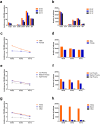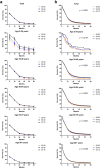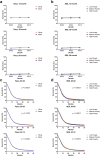Survival changes in patients with small cell lung cancer and disparities between different sexes, socioeconomic statuses and ages
- PMID: 28465554
- PMCID: PMC5431017
- DOI: 10.1038/s41598-017-01571-0
Survival changes in patients with small cell lung cancer and disparities between different sexes, socioeconomic statuses and ages
Abstract
Small cell lung cancer (SCLC), as a proportion, makes up only 15-17% of lung cancer cases. The development of treatments for SCLC has remained stagnant for decades, and SCLC is expected to persist as a threat to human health. To date, no publications based on large populations have been reported. We calculated survival changes in patients with SCLC during each decade between 1983 and 2012 to determine the roles of race, sex, age, and socioeconomic status (SES) on survival rates based on the Surveillance, Epidemiology, and End Results (SEER) registries. In total, 106,296 patients with SCLC were identified, with the overall incidence per 100,000 decreasing each decade from 9.6 to 7.8 to 5.8. The median survival for SCLC remained 7 months, and the 12-month relative survival rates (RSRs) remained relatively stable at 32.9%, 33.2% and 33.2% during each decade. The 5-year RSRs significantly improved from 4.9% to 5.9% to 6.4% during each decade, but remained extremely low. In addition, a narrowing of the survival gaps among SES groups and stable survival gaps between sexes were observed. Although the incidence of SCLC decreased during each decade, the overall survival remained relatively stable, highlighting the urgency of developing novel treatments and the importance of prevention and early detection.
Conflict of interest statement
The authors declare that they have no competing interests.
Figures




References
Publication types
MeSH terms
LinkOut - more resources
Full Text Sources
Other Literature Sources
Medical

